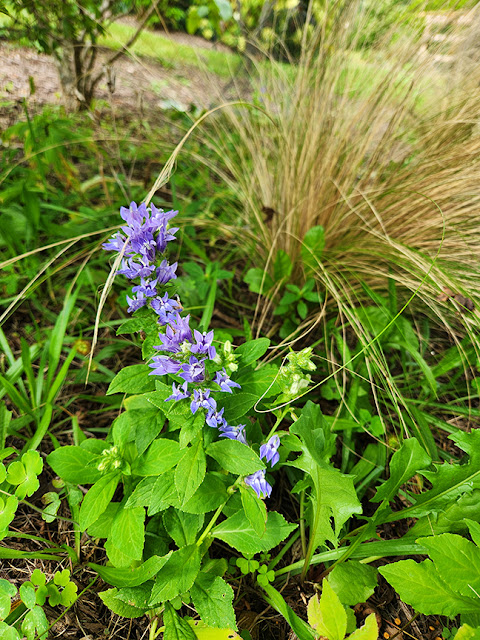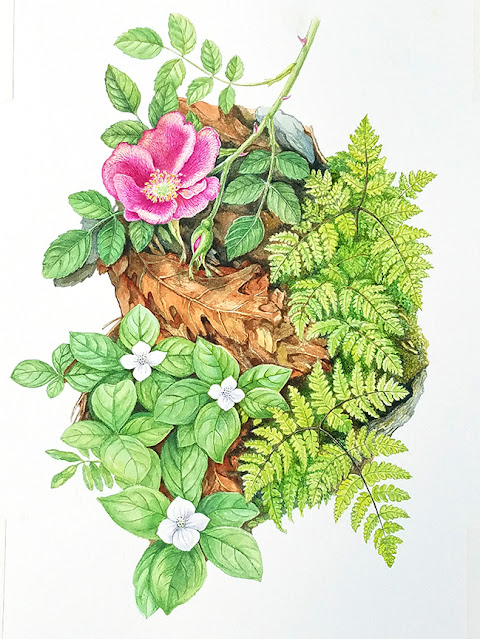 |
| Blue Lobelias in east garden. |
 |
| All-whilte Lobelia. |
A very wet August brought us respite from the heat and drought--I recorded over 11 inches of rain during the month of August this year--and my garden seems to have revived to nearly normal. Every 15th of the month is Bloomday, hosted by Carol Michel's May Dreams Garden blog, so welcome to my September garden: let's take a look at what's blooming.
The deer ate back the buds of most of my Blue Lobelias, but after the rains the plants recovered enough to offer a nice array of flowers. They really set off the area of my east garden where I've been trying to create a shady woodland. I had just pruned the Japanese maple tree which I grew from a 6" seedling twelve years ago when I took this photo. I even found one all-white Lobelia in there--a sport or mutant? Lovely in any case!
I have two other Japanese maples in my little woodland, as well as a Carolina Silverbell tree and a Pagoda dogwood. The bed is finally starting to look somewhat as I had envisioned, but will need a few more years' growth to achieve fullness.
 |
| The east garden miniature woodland |
Also on the east side of the house, my Viburnum 'Brandywine' is making a wonderful display as its berries turn from pink to blue.
 |
| Viburnum 'Brandywine' berries |
Moving on towards the back yard, the "Autumn Joy' Sedum is looking nice next to the wild blue Ageratum--unfortunately deer are very fond of this Sedum so it must be kept protected or there would be nothing left. I call this the "Herb bed" because my husband Herb dug the first part of it. Our hummingbirds love the red Salvia as well as the Brazilian Salvia 'Black and Blue.'
 |
| Red Salvia 'Windwalker Royal Red' |
Behind this bed I have a witchhazel variety named 'Diane' flanked by two Viburnums I grew from seed collected at Brookside Gardens in Maryland--by the look of the leaves I think these may be Leatherleaf Viburnum. And one of these has developed some flower buds--unseasonably, it seems to me. I'm curious to see what the flowers and subsequent fruit will look like. It may reveal more about the particular species.
More interesting is to note the chewed-up leaves. A number of clearwing hummingbird moths visited my garden this summer, and Viburnum is the host plant for the caterpillar of this moth, so I hope they are feeding on my Viburnums and will make my garden their home.
 |
| Leatherleaf Viburnum? budding. |
I recently planted one of three Gaultherias I bought this past spring under the witchhazel tree after treating the soil with acidifier. Let's hope it survives and prospers. The alkalinity of the soil here can be a problem for many acid-loving plants.
 |
| Prairie sage and wild sunflowers. |
A lovely color combination found in the back-most bed I call "The Badlands" was this blue sage (Salvia azurea) with some late-blooming native sunflowers. My display is still very skimpy, but hopefully will grow fuller with time if I can get the deer to stop eating it. Deer aren't supposed to eat salvias, but they will browse it if nothing else is available, and the sunflowers too.
 |
| Beautyberry (Callicarpa dochotoma 'Early Amethyst') |
My two Beautyberry 'Early Amethyst' bushes are displaying their lovely berries and haven't been too badly chewed by the deer. And there are still some flowers on my butterfly bushes, they're finishing as other fall flowers come into bloom.
 |
| Butterfly bush 'Miss Molly' |
I spent the past two days cleaning up a bed on the west side of the house--the crabgrass was almost up to my knees!--and while doing so, I transplanted a lovely wild purple aster that I'd found in the very back of the yard near my neighbor's fence. The aster was so tall I had to cut off the top so it wouldn't pull out of the ground, but hopefully it will recover and show even better next year. This one was a volunteer, I think it came from seeds collected in Warm Springs, VA, a few years back. Some times these volunteers can be wonderful additions to a native garden.
 |
| Purple aster with Caryopteris shrub in the west bed. |
Also on the west garden, my Ceanothus 'Gloire de Versailles' has recovered from the browsing and is producing some blooms. This plant is a hybrid of the native New Jersey tea plant (Ceanothus americanus) with the California native lilac. Its flowers are fragrant.
 |
| Ceanothus 'Gloire de Versailles' |
In the front yard on the west, my Abelia "Panoramic Color Radiance' did not get too badly eaten this year, and has some lovely blooms.
 |
| Abelia 'Panoramic Color Radiance' |
The dogwood tree in front of the house is starting to show its fall foliage. And the deer left me a few hardy begonias under the cherry tree to flower and re-seed themselves, only because of timely spraying with repellent.
 |
| Dogwood tree and front walk. |
 |
| Hardy begonias. |
Some of my potted plants are looking good too--the white Heliotrope on the front walk is lovely, as are the porch hanging baskets.
 |
| White Heliotrope. |
 |
| Fuchsia in hanging basket. |
 |
| Porch hanging basket. |
The tuberous Begonia in the hanging basket on the back deck is still blooming but starting to fade, while the Salvia 'Black and Blue' is holding its own. The humming birds love this plant and we've had quite a few of them visiting our deck. Most of them don't seem to be bothered by our close proximity and feed while we're there, but a few are very shy.
 | |
| Tuberous Begonia on the back deck. |
 |
| Salvia 'Black and Blue' |
I hope you've enjoyed this stroll through my garden on a lovely September day. Can't wait to see what the Autumn Equinox will bring!
































